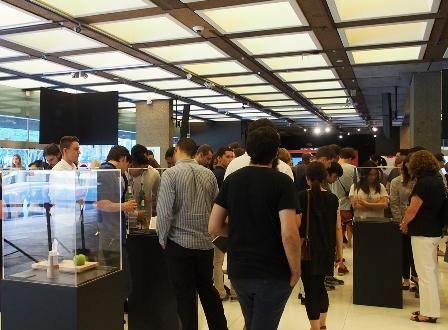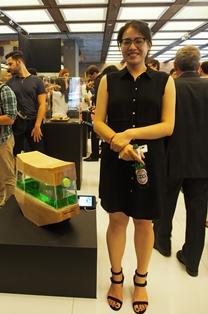
Brooke Zhang and Nick Kewley have just finished their 4th year of Bachelor of Design in Industrial Design (now called Integrated Product Design) at UTS. Inspired by a talk from C3 Director, Professor Peter Ralph, the final year students took up the challenge to design objects that would create awareness about the importance of microalgae. Both students’ work was chosen for the final year exhibition that showcased the work of students from the Bachelor of Industrial Design, Bachelor of Integrated Product Design and Master of Design programs. Integrated product design expands on the traditional field of industrial design to reflect the changed realities of the globalised design profession.
Product brief: what problem were you trying to solve?
“Peter came at the beginning of the year and presented a brief that, while very ‘blue sky’, was primarily about heightening awareness around the importance of microalgae as an organism as well as engendering a change in public perception,” Nick Kewley explains.
“Peter’s issue was that although microalgae have numerous benefits for industry, such as bio fuels and bio plastics, there persists a negative connotation among the general public around algae, largely due to some species causing harmful blooms. The sooner the general public accepted microalgae as a viable option for helping to combat climate change, the easier it would be to acquire funding and further the research into the organism.”
While this was the initial brief, with the help of Pofessor Ralph, both projects evolved to encompass related or complimentary issues.
“Throughout the first semester, we have had several meetings and interviews with Peter, which further shaped the concept and purpose of the project into a more refined direction,” says Ms Zhang.
“With my project, the brief was to create an object that allows the user to build up a symbiotic relationship with microalgae through interaction. At the same time, to create a conversional piece that integrates microalgae into people’s daily life. Thus to help the audience to better understand the potential of microalgae and grow their interest in them.”
For Nick, research pointed to children as an under targeted demographic of early technology adoption.
“Coupled with the steady decline in STEM uptake among children, this presented an opportunity to design an educational children’s product that used microalgae to reignite interest in science, while simultaneously teaching them about the importance of the organism,” says Mr Kewley.
The products – what are they? How are they made?
Nick Kewley

"Candeo’"(latin for ‘to be brilliant’, ‘to glow’) is billed as a cross between Sea Monkeys and a Tamagotchi. The device bridges the gap between the physical and virtual pet by offering a device that allows children to grow and monitor their own culture of bioluminescent algae (Pyrocystis fusiformis) through a device and app. By conducting experiments and agitating the culture by rocking the device, causing it to glow, children are performing hands on science while forming an emotional bond with their algal ‘pet’. This symbiotic relationship is cemented by having the user exhale carbon dioxide into the flask, which helps the culture photosynthesise, in turn enriching the child’s room with oxygen.
‘Candeo’ is made from a number of materials, selected for either their beneficial properties for the user, the device or the organism. Taking the form of a scientific flask the primarily plastic device features a BPA free copolymer flask, a one way valve to prevent accidental ingestion, as well as a water resistant, air permeable synthetic material to allow for gas exchange. Candeo features soft touch textures to invite interaction, while using a juxtaposition of both matt and gloss finishes to intuitively inform the user how parts should interact with one another.

Brooke Zhang
SHENG is a conversational, interactive rocking stool that creates a symbiotic relationship between microalgae and the user. Integrating the crucial elements needed to grow microalgae into a self-sustaining system, the interaction between user and stool welcomes algae into the home, altering public perceptions. To maintain the health of the algae, users are required to constantly interact with the stool. While in use, the rocking motion pumps carbon dioxide (CO2) through the culture, feeding the algae, and in turn dispersing oxygen into the home.
The top and bottom are CNC’d American Rock Maple with acrylic coating (semi-gloss to matt finish). The 2 part clear acrylic body is heat bended and welded together, and the acrylic tank is butt jointed together.
The role of the external advisor was very important for the success of the projects, Ms Zhang says.
“Throughout the design process, Peter gave us great support on the academic research aspect as well as suggestions and advice on the concept. He also have provided lab access and helped us to cultivate the microalgae. Importantly Peter also helped us to gain more exposure for our products and provided the opportunity for us to meet people from different industries.”

